Topexaminer001
i am a health and medical practioner who is specialised in helping students to equip skills in nursing,mathematics and more about economics.
My documents will able to meet your needs adequately.
- 348
- 0
- 0
Community
- Followers
- Following
348 items
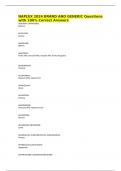
NAPLEX 2024 BRAND AND GENERIC Questions with 100% Correct Answers
NAPLEX 2024 BRAND AND GENERIC Questions with 100% Correct Answers ABACAVIR/ LAMIVUDINE: Epzicom ACYCLOVIR: Zovirax ADAPALENE: Differin ALBUTEROL: ProAir HFA, Proventil HFA, Ventolin HFA, ProAir Respiclick ALENDRONATE: Fosamax ALLOPURINOL: Zyloprim (PO), Aloprim (IV) ALPRAZOLAM: Xanax ALVIMOPAN: Entereg AMIODARONE: Pacerone (PO), Nexterone (IV) AMLODIPINE: Norvasc AMLODIPINE/ BENAZEPRIL: Lotrel AMOXICILLIN/ CLARITHROMYCIN/ LANSO...
- Exam (elaborations)
- • 23 pages •
NAPLEX 2024 BRAND AND GENERIC Questions with 100% Correct Answers ABACAVIR/ LAMIVUDINE: Epzicom ACYCLOVIR: Zovirax ADAPALENE: Differin ALBUTEROL: ProAir HFA, Proventil HFA, Ventolin HFA, ProAir Respiclick ALENDRONATE: Fosamax ALLOPURINOL: Zyloprim (PO), Aloprim (IV) ALPRAZOLAM: Xanax ALVIMOPAN: Entereg AMIODARONE: Pacerone (PO), Nexterone (IV) AMLODIPINE: Norvasc AMLODIPINE/ BENAZEPRIL: Lotrel AMOXICILLIN/ CLARITHROMYCIN/ LANSO...
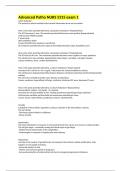
Advanced Patho NURS 5315 exam 1
Advanced Patho NURS 5315 exam 1 action potential The process by which excitable cells transmit information from one to another. How is the action potential altered by a potassium imbalance? (Hyperkalemia) The ECF has more K+ ions. The membrane potential becomes more positive (hypopolarized). Cells become MORE excitable. T waves peak. QRS complexes widen. Causes dysrhythmias, weakness, paresthesia. {If membrane potential becomes equal to threshold potential cardiac standstill occurs}...
- Exam (elaborations)
- • 19 pages •
Advanced Patho NURS 5315 exam 1 action potential The process by which excitable cells transmit information from one to another. How is the action potential altered by a potassium imbalance? (Hyperkalemia) The ECF has more K+ ions. The membrane potential becomes more positive (hypopolarized). Cells become MORE excitable. T waves peak. QRS complexes widen. Causes dysrhythmias, weakness, paresthesia. {If membrane potential becomes equal to threshold potential cardiac standstill occurs}...
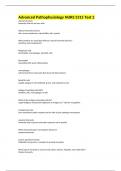
Advanced Pathophysiology NURS 5315 Test 2
Advanced Pathophysiology NURS 5315 Test 2 natural immunity immunity that we are born with Natural Immunity barriers skin, mucus membrane, natural killer cells, protein What protiens are associated with our natural immunity barriers? Cytokines and complements Phagocytic cells Neutrophils, macrophages, dendritic cells Neutraphils Associated with acute inflammation macrophages cells formed from monocytes that leave the blood stream Dendritic cells engulfs antig...
- Exam (elaborations)
- • 18 pages •
Advanced Pathophysiology NURS 5315 Test 2 natural immunity immunity that we are born with Natural Immunity barriers skin, mucus membrane, natural killer cells, protein What protiens are associated with our natural immunity barriers? Cytokines and complements Phagocytic cells Neutrophils, macrophages, dendritic cells Neutraphils Associated with acute inflammation macrophages cells formed from monocytes that leave the blood stream Dendritic cells engulfs antig...
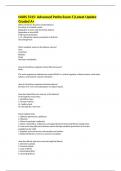
NURS 5315: Advanced Patho Exam 5|Latest Update Graded A+
NURS 5315: Advanced Patho Exam 5|Latest Update Graded A+ What are the key functions of the kidneys? Excretion of metabolic waste. Regulation of water and electrolyte balance Regulation of arterial BP Erythrocyte production 1, 25 -dihyydroxy vitamin production (calcitriol) Gluconeogenesis What metabolic waste do the kidneys excrete? Urea Creatinine Bilirubin Drugs Hormone metabolites How do the kidneys regulate arterial blood pressure? RAAS The renin-angiotensin-aldoster...
- Exam (elaborations)
- • 21 pages •
NURS 5315: Advanced Patho Exam 5|Latest Update Graded A+ What are the key functions of the kidneys? Excretion of metabolic waste. Regulation of water and electrolyte balance Regulation of arterial BP Erythrocyte production 1, 25 -dihyydroxy vitamin production (calcitriol) Gluconeogenesis What metabolic waste do the kidneys excrete? Urea Creatinine Bilirubin Drugs Hormone metabolites How do the kidneys regulate arterial blood pressure? RAAS The renin-angiotensin-aldoster...
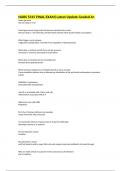
NURS 5315 FINAL EXAM|Latest Update Graded A+
NURS 5315 FINAL EXAM|Latest Update Graded A+ Anion gap level Normal range is 3-10 Osmol gap normal range and heat does an elevated value mean Normal range is <10 mOsm/kg; elevated levels indicate ethyl alcohol (etoh) consumption What triggers renin releases Triggered by dehydration; involved in the regulation of blood pressure What does a cirrhosis and HF do to oncotic pressure Increased in cirrhosis; decreased in heart failure What does an elevated serum osmolality p...
- Exam (elaborations)
- • 9 pages •
NURS 5315 FINAL EXAM|Latest Update Graded A+ Anion gap level Normal range is 3-10 Osmol gap normal range and heat does an elevated value mean Normal range is <10 mOsm/kg; elevated levels indicate ethyl alcohol (etoh) consumption What triggers renin releases Triggered by dehydration; involved in the regulation of blood pressure What does a cirrhosis and HF do to oncotic pressure Increased in cirrhosis; decreased in heart failure What does an elevated serum osmolality p...

NURS 5315 Advanced Pathophysiology
NURS 5315 Advanced Pathophysiology Clinical implication for Beta blockers? (book) Atrial fibrillation, chronic left heart failure or reduced ejection fraction Beta Blockers (book) reduce myocardial demand. By blocking beta receptors. Myocardial contractility is a change in developed tension at a given resting fiber length, which is simply the ability of the heart muscle to shorten. At the molecular level, thin filaments of actin slide over thick filaments of myosin called the cr...
- Exam (elaborations)
- • 7 pages •
NURS 5315 Advanced Pathophysiology Clinical implication for Beta blockers? (book) Atrial fibrillation, chronic left heart failure or reduced ejection fraction Beta Blockers (book) reduce myocardial demand. By blocking beta receptors. Myocardial contractility is a change in developed tension at a given resting fiber length, which is simply the ability of the heart muscle to shorten. At the molecular level, thin filaments of actin slide over thick filaments of myosin called the cr...
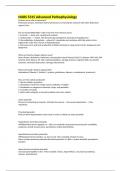
NURS 5315 Advanced Pathophysiology
NURS 5315 Advanced Pathophysiology Ovarian cancer site of metastasis? Peritoneal surfaces, omentum (fold of peritoneum connecting the stomach with other abdominal organs), liver The increased NADH/NAD+ ratio in the liver from ethanol causes: 1. Pyruvate --> lactic acid, causing lactic acidosis 2. Oxaloacetate --> malate. This prevents gluconeogenesis and leads to hypoglycemia 3. Glyceraldehyde-3-phosphate --> glycerol 3- phosphate and combines with fatty acids to form triglyce...
- Exam (elaborations)
- • 13 pages •
NURS 5315 Advanced Pathophysiology Ovarian cancer site of metastasis? Peritoneal surfaces, omentum (fold of peritoneum connecting the stomach with other abdominal organs), liver The increased NADH/NAD+ ratio in the liver from ethanol causes: 1. Pyruvate --> lactic acid, causing lactic acidosis 2. Oxaloacetate --> malate. This prevents gluconeogenesis and leads to hypoglycemia 3. Glyceraldehyde-3-phosphate --> glycerol 3- phosphate and combines with fatty acids to form triglyce...
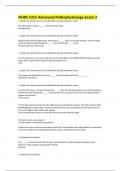
NURS 5315 Advanced Pathophysiology-Exam 3
NURS 5315 Advanced Pathophysiology-Exam 3 1. Explain the cardiac structure and blood flow through chambers/valves. The right atrium receives ______ blood from the body. deoxygenated 1. Explain the cardiac structure and blood flow through chambers/valves. Blood travels from the right atrium, through the ______ valve, to the right ventricle. From the right ventricle, blood travels through the _____ valve and into the ____ artery tricuspid, pulmonic, pulmonary 1. Explain the card...
- Exam (elaborations)
- • 5 pages •
NURS 5315 Advanced Pathophysiology-Exam 3 1. Explain the cardiac structure and blood flow through chambers/valves. The right atrium receives ______ blood from the body. deoxygenated 1. Explain the cardiac structure and blood flow through chambers/valves. Blood travels from the right atrium, through the ______ valve, to the right ventricle. From the right ventricle, blood travels through the _____ valve and into the ____ artery tricuspid, pulmonic, pulmonary 1. Explain the card...
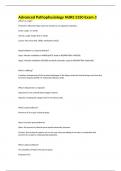
Advanced Pathophysiology NURS 5350 Exam 3
Advanced Pathophysiology NURS 5350 Exam 3 What is a cough? Protective reflex that helps clear the airways by an explosive expiration. Acute cough: 2-3 weeks Chronic cough: longer than 3 weeks. Causes: Post nasal drip, GERD, medications (ACE). Hypoventilation vs. Hyperventilation? Hypo: Alveolar ventilation is INADEQUATE: leads to RESPIRATORY ACIDOSIS. Hyper: Alveolar ventilation EXCEEDS metabolic demands: Leads to RESPIRATORY ALKALOSIS. What is clubbing? A pai...
- Exam (elaborations)
- • 25 pages •
Advanced Pathophysiology NURS 5350 Exam 3 What is a cough? Protective reflex that helps clear the airways by an explosive expiration. Acute cough: 2-3 weeks Chronic cough: longer than 3 weeks. Causes: Post nasal drip, GERD, medications (ACE). Hypoventilation vs. Hyperventilation? Hypo: Alveolar ventilation is INADEQUATE: leads to RESPIRATORY ACIDOSIS. Hyper: Alveolar ventilation EXCEEDS metabolic demands: Leads to RESPIRATORY ALKALOSIS. What is clubbing? A pai...

NURS 5315: Advanced Pathophysiology UTA Exam 1 Questions with 100% Correct Answers Atrophy
NURS 5315: Advanced Pathophysiology UTA Exam 1 Questions with 100% Correct Answers Atrophy E. Cells decrease in size P. Still functional Physiologic: thymus gland in early childhood Pathological: disuse Hypertrophy E. Increase in cell size P. Increased workload Physiologic: weightlifting Pathologic: cardiomegaly from HTN Hyperplasia E. Increase in cell number P. Increased cellular division Physiologic: liver regeneration Pathologic: endometrial- usually r/t hormones D...
- Exam (elaborations)
- • 9 pages •
NURS 5315: Advanced Pathophysiology UTA Exam 1 Questions with 100% Correct Answers Atrophy E. Cells decrease in size P. Still functional Physiologic: thymus gland in early childhood Pathological: disuse Hypertrophy E. Increase in cell size P. Increased workload Physiologic: weightlifting Pathologic: cardiomegaly from HTN Hyperplasia E. Increase in cell number P. Increased cellular division Physiologic: liver regeneration Pathologic: endometrial- usually r/t hormones D...
